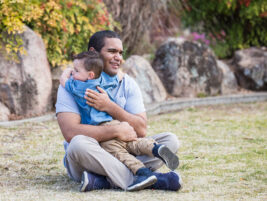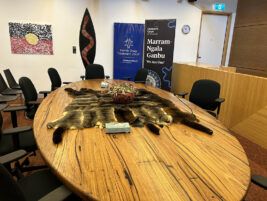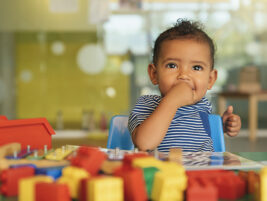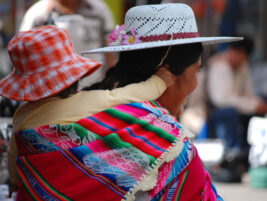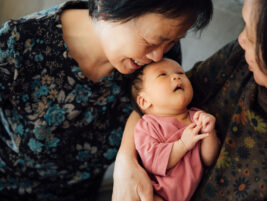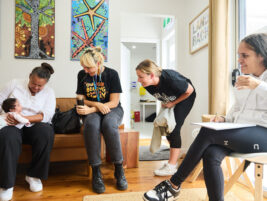Hisako Watanabe is a child psychiatrist in Japan who trained at the Tavistock Clinic in England in mid-career and returned to Japan to pioneer infant mental health practices in Japan. She has spent the last four decades of her career integrating western transdisciplinary, neurobiological, and psychodynamic approaches with the embodied and intuitive experiences of parenting. Watanabe uses her understanding from work with babies and families to explore how humans have survived, adapted, and developed over centuries. In an exclusive WAIMH Perspectives in Infant Mental Health interview, Watanabe shares below her ongoing exploration of the Japanese concept of ‘Amae’ and her journey toward an integrated approach to Infant Mental Health that honors the deep wisdom inherent in Japanese ways of being. She transposes this understanding to that of creating a space for hope and revival of communities that have faced catastrophic disasters in Japan. Her approach provides a framework not only for infant mental health practitioners but also clinicians who support individuals facing humanitarian and environmental crises around the globe.
On the Root of Being Human
“Nearly four decades on since starting this work, and I am still learning from infants! I’m learning from infants about the root of what it is to be human, evolving from standing on two feet and then coming out of the rainforest and surviving, figuring things out along the way. How have we as humans gone from not having any words to relying on intellectual theories to make major decisions at the global level? While for a long time, we didn’t have any words or theories, we now consider words and theories to be something we depend on in our everyday lives. But you know, in fact, looking back into the history of human evolution, use of theories came quite late, perhaps more abundantly after the industrial revolution of the West. So, I am now humbly learning again about the roots of human existence and reflecting on the importance of ‘being with’ and ‘authenticity’. And, this is an urgent theme for me, because while we can create good ideas and put them into words, there’s no assurance that these language-based symbolic representation will work for people who do not rely on verbal representation to express ideas. Sometimes, words or language- or number-based frames can limit what’s possible in terms of expressions and communication, including mutual understanding between people. I have learned over the years to reflect on and notice how I have internalized the western ways of valuing the written word, reading, and writing words to convey ideas and pass on wisdom. I have had to engage in very intentional unlearning of giving so much power to the written word and instead paying attention to much broader range of expression of what’s happening on this earth in our current everyday life. Words sometimes fail to convey what is really the essence and meaning of life and what are the core ingredients that make people happy. For example, I am a pianist, and there are certainly things that I can only feel or express when I am at the piano, a kind of vitality affect. Artists and dancers may experience something similar where an internal transformation is possible through their artistic movement and expression. Words could have more potentials, when used creatively, as in poetry or in a song form, perhaps, far from very prescriptive and restrictive ways words are used in clinical language.
And this brings me to the importance of the underlying intention of communication, which for example, infants are highly receptive to and can sense whether what we are saying is from our heart or from our mind, and the underpinning intention. And there are many times when we are talking, that it does not come from our heart or our real intention, and infants, young children and adolescents, can perceive that and may find the person who is talking to be disingenuous or lacking in authenticity. And this is very important in our current times because I think that infants really need authentic interactions with their important people and environment because they live in a state of primitive anxiety from having to evolve in an unforeseen world, especially at this historical timepoint when things are very threatening in many respects. Capitalism and various other systems of oppression can erode authentic interactions by targeting the sacred relationships between infants and their caregivers through various stresses, pressures, and maltreatments happening in current societies. Young children and the new generations are always keenly aware of our motives and can discern whether what we are saying is underpinned by a genuine interest or is rooted in rhetoric and other motivations.
When we have a healthy ability to grasp the true intention behind the words presented to us, then we can navigate ourselves much more wisely and securely. People who are secure inside, having been nurtured well with a secure attachment and have developed a very positive self-esteem and a basic trust in the world and life, can do better because they know they have the space to stop. This kind of space is something perhaps we adults in an industrialized world are losing while primitive people and younger human beings are more receptive to. And it is this sensing and space…that is so important in the helping relationship.”
Vitality Affects of the Womb: Creating a Psychological Amniotic Fluid
“Vitality affects refer to a specific intrasubjective sense of energy, and a sense of aliveness. Vitality affects are a separate kind of experience that emerge in an encounter with dynamic movements, which are either conscious or unconscious. We have a lot to learn from the fetus, and from neonates and infants as they come into this world, with inner movement that leads to vitalization in ways that promote processes of inner change and in turn improves health. These days, many infants enter a world very different from those known by our indigenous peoples, or our ancestor’s society, and the ways in which they manage to adapt themselves despite these changes if they are to survive. They have a plasticity and flexibility and competency that we should respect. We should respect all people without a voice, not only infants, but also other individuals born with congenital anomalies, and people who have been silenced by various systems of oppression and interpersonal violence.
Although Japan has modernized, we still have many silent people. These are the people who experienced the Great East Japan Earthquake and Tsunami in 2011 when the Fukushima Nuclear Plant was blasted following the earthquake and tsunami. These survivors are very modest and view silence as golden. So, there have never been any riots or protests despite the suffering of these people. But while they may pray silently, this is at the cost of their ego expression, because while superficially their towns have been rebuilt, the mourning of the losses of the deceased and the losses of their land and their community are only really beginning now. People are only now slowly speaking out and sharing these feelings and experiences, and I’m sure this process will take decades and decades because there are many people whose remains have yet to be retrieved and there are many, many painful stories that are still hidden inside families. And while the new traumas such as the Great East Japan Earthquake and Tsunami of 2011 has triggered hidden, repressed conflicts of the past to come out as well, people start to feel complex emotions which make them too frightened to talk about and they continue to pretend that nothing has happened. However, there are people who realize that unless we face the reality and strive to save the stories and pass them down to the next generation, the next generation will also suffer from this trauma. So, while there is quite a spectrum of reactions in the aftermath of the Great East Japan Earthquake and Tsunami, I think it’s an opportunity for us to really talk with each other.
This is where the infant mental health principles work very well, because I went into the disaster areas, where people generally do not want any intruders. Yet, I was invited to talk and I told them that learning in the field of mental health teaches us that we live in movement from the very beginning of our life in the womb until the very end of our life, when our heartbeat stops. This vitality affect begins inside the womb; look at the way the fetus moves! And it is movement which stimulates brain development. My sharing perspectives from infant mental health principles struck a chord with these people from the disaster areas and they kept inviting me to consult on cases of children, infants, or families about whom they felt confused or helpless or even hopeless. I would, using the infant-parent psychotherapy mode of reframing the interaction in a positive light, try to ease the care providers of their sense of hopelessness, and help them with their feeling driven to do something to make people better or restore them quicker. I told them, “you know, this person comes to you and complains to you in such a furious, confused way. Why? Because you are the care provider and you have the whole trust of that victim who feels at home in your space. They are feeling like a fetus in your amniotic fluid. Your consistency, your patience, your concern…is creating a psychological amniotic fluid. And that is very important for them. So, when being in the presence of someone, pay attention to your gut…and when you start to feel from your gut, from your inside, then you will really start to resonate with the person with all the movements and all their words that you find so hard to hear.” And they were very wise in utilizing my little bit of advice in terms of the person being in ‘your psychological amniotic sack’. So, let her kick, let her move. It’s a sign of reviving.
So, we need to be our true selves; open and receptive to the people who have been afflicted and survived calamity that we have not personally experienced, and we should really remember that the way we are suffering is their way of sharing a taste of the pains of their sufferings. So let us be thankful that we are being trusted to taste the agony that they have survived…because this agony will really become the basis of their resilience once it has been genuinely understood by someone.”
The Journey to ‘Amae’
“In my work, I have faced very depressed mothers who made me feel – ‘if I send her out of this room, she might commit suicide at any moment’. I have also extensively treated young women who were dying due to anorexia. And while I found myself voraciously reading many good books to understand these situations better, there was one person who said, “leave the book…she [the patient] is an expert on her eating disorder” … and she helped me to understand about something called the constructive use of ignorance. This means, just forget about any academic or clinical knowledge you have learned already. Yes. Just forget about it… Just meet the person as they are, and to be open to the fact that you don’t know anything about this person. Just as the baby comes into the world, frightened, but also very, very, curious, to relate to us. Such is the case with Hilde Bruch’s, ‘The Constructive Use of Ignorance,’ which is underpinned by the model of infants trying to live a good life, curious, open and very receptive, but not pushing anything, not intrusive, not labeling anything. And this really helped me to become much more open. So, I took each dying anorexic girl, very determined and challenging, as my teacher, to teach me through the gut feelings of what it is like to have to push oneself into the dying state for survival.
To explore this sort of approach further, I attended the third WAIMH Congress in Stockholm, Sweden, 1986. And lo and behold, I met T.B.Brazelton from Harvard University.
He was studying infants and mothers in the Goto Islands off the coast of Kyushu, Japan, and he was talking to the audience, that how on these Japanese islands, child rearing was baby-centered. Everybody was on the same eye level with a baby because we the Japanese sit on the tatami mat on the floor… and the baby would initiate by saying “coo” and everybody, grandparents, parents and siblings, and everybody, neighbors, they would “coo” back to the baby. It was a harmonious world for infants. He told me, “your country has the most exquisitely, intricate, soft infancy, so go and study yourself and your culture.” This was mind boggling, because having studied in medical school, this was a quite different way of thinking about the world. This made me curious to understand the genuine Japanese way of life. And this was how I arrived in the world of ‘Amae’.
‘Amae’ has to do with our understanding and perception of each other, and can often be experienced and expressed nonverbally… as in ‘silence is golden.’ Amae has been described as the desire “to depend and presume upon another’s love or bask in another’s indulgence (https://unseen-japan.com/debunking-amae/) and is perhaps nowhere better typified than that the mother-infant relationship and the tacit often non-verbal interactions that characterize this. I went in search of further understanding about this in Bangladesh to see Rohingya people in refugee camps. They didn’t have written words, but they had oral communications of chanting and songs, gestures, and drawings. And so, there are people on earth, minorities who still cherish oral communication, tacit understanding and live with rich affective communication without written words. This is something I thought we must preserve for the sake of the future because we have become too intellectually armored, which has led to the impoverishment of our intuitive parenting and intuitive community life. But only bit by bit did I arrive at this understanding. All my patients, from all over Japan teaching me to be respectful of whatever they have experienced as wisdom, even shameful experiences that are taboo in our society, tacitly understanding that “you must be a person who has survived unspeakable agony and trauma”. I am very curious to get in touch with people, who have lived beyond my horizon of understanding; and the more curious I am and the deeper I listen, the better I understand.”
Expanding Infant Mental Health Concepts to Families Living in Current Crises
“I have contributed one chapter in the Infant Mental Health Handbook, which is due to be published this spring: a piece called Reviving the Inner Nurturing Capacities of Families in An Unpredictable World. In the chapter, I wrote about how I have over the years come to realize that infant mental health as a field of work has more potential than I had initially thought. It really provides the wisdom and understanding to those of us who are facing these global crises in terms of so many things happening at once. And my work with anorexia, disaster response, and the transgenerational transmission of trauma in the infant-parent psychotherapy model, have all come together like a puzzle, connecting, and reinforcing each other. While infant mental health and infant-parent psychotherapy work are often very much located inside the treatment room, they need to be applied in the evacuation areas and disaster response spaces as well. So long as we are true to our curiosity and genuinely wish to learn from cases in whatever situations, there is the potential for us to grow. And there are people in this field, who are natural infant mental health professionals, already doing amazing work that aligns with their community’s cultural heritage and wisdom, but who have no ‘academic’ credentials. Those are the people that I would be honored to support. Local community members should be supported to get training so that even if babies and children are inside the disaster area, the local care providers are able to create a little bit of secure space, where individuals can be themselves, like children playing with each other and parents and children finding moments of connection and joy. Parents finding moments of relief. Family members and community members can find their way to becoming themselves again. That sort of very simple essence of healing, learning, and growth is what I think the world should really start thinking about.”
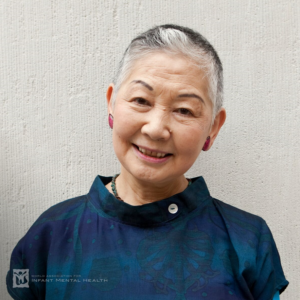
References
Bruch, H. (1975). The Constructive Use of Ignorance. In J. Anthony (Ed.), Explorations in Child Psychiatry (pp. 247-264). New York: Plenum
Doi, T. (1971). Amae no Kozo: The Anatomy of Dependence. U.S.A:Kodansha.
Fraiberg,S. (1983). Treatment Modalities. In J. Call, E.Galenson, & R. Tyson (Eds.), Frontiers of Infant Psychiatry Vol 1. (pp. 56-73). New York: Basic Books.
Watanabe, H. (2007). Innovation in parent-infant psychotherapy in Japan: the infant reveals family trauma. In M.E.Pozzi-Munzo, & B.Tydeman (Eds), Innovations in Parent-Infant Psychotherapy ( pp231-245). London: Karnac.
Watanabe, H. (2002). The transgenerational transmission of abandonment. In J.M.Maldonado-Duran (Ed.), Infant and Toddler Mental Health: Models of Clinical Intervention with Infants and their Families (pp.187-206). New York: American Psychiatric Publications.
Watanabe, H., Kikuchi, S. Narui, K et al (2019) Japan’s Fukushima Daiichi Nuclear Power Plant Accident. In C.W.Hoven, L.V. Amsel & S.Tyano (Eds) An International Perspective on Disasters and Children’s Mental Health (pp167-190) Springer Nature Switzerland.
Watanabe, H. (2024). Reviving the Inner Nurturing Capacities of Families in the Unpredictable World: A Japanese Perspective on Infant Mental Health. In J.D. Osofsky, H.E. Fitzgerald, M Keren & K. Puura (Eds) WAIMH Handbook of Infant and Early Childhood Mental Health Vol 2: Cultural Context, Prevention, Intervention, and Treatment in Infant Mental Health, Springer Nature Switzerland (in press)
Authors
Watanabe, Hisako (Japan)
Maharaj, Salisha (South Africa)



